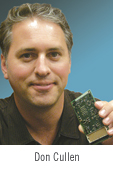
Scratching the surface of surface finishes.
I’ve written a fair number of articles on surface finishes, so whenever I read a white paper, my vanity forces me to check the reference list to see if my name is included. I am always surprised when I find that my most often referenced publication is “Comparing Today’s HASL Alternatives.” This 1999 article isn't new, so what explains it's staying power?
There is something very fundamental to that piece because it outlines the very basics of surface finishing. It is often the coverage of basic concepts that is most widely received because readers have diverse specializations and look to the experts for specifics.
The granddaddy of PCB surface finishing is Hot Air Solder Level (HASL). In this process, bare circuits are slipped through molten solder alloy. As the PCB is removed, knives of hot air attempt to remove excess solder. HASL has endured for the past 20 years or so mainly on the weaknesses of all the other finishing ideas and on the vast infrastructure deployed to support HASL. Those dissatisfied with HASL made real inroads into the use of OSP (Organic Solderability Preservative) mainly to take advantage of OSP’s flatness.
While OSP continues to do well in the marketplace, undergoing the occasional resurgence, its path to success has not been smooth. AT&T, IBM, the October Project and others certified the original “defect” of exposed copper to be a non-issue but for some, this artifact of bare copper circuitry that is exposed by flux and incomplete solder wetting remains an issue. Later, the mandate to replace Freon at component assembly with the use of low-residue fluxes became a major challenge for the finicky solderability of OSP. Inspectability, contact functionality and through-hole soldering remain challenges to OSP. Today, we’re witnessing the latest OSP re-invention with new “high temperature” coatings.
Having endured enough downsides of HASL and OSP, many OEM’s decided to bite the bullet of higher cost and specify electroless nickel immersion gold (ENIG) surface finish. Locked in with tough nickel and precious gold, what could go wrong? Black Pad, that’s what. After endless service calls, years of research and even worse, industry committee meetings, I have reached the conclusion that the black pad moniker is ascribed to general soldering problems far more frequently that the actual insidious defect itself. That doesn’t stop OEM’s from shunning ENIG. More enlightened designers have begun the path back to ENIG using cost/benefit analyses. Process complexity might slap these ENIG lovers with Murphy’s Law yield loss. Only time will tell.
The overworked, underpaid assembly engineers finally achieved success with the new immersion finishes. Starting with immersion silver during the late 1990’s and then with immersion tin within the past several years, we have seen a widespread deployment of these very thin metal coatings for soldering, contact and various other functional performance reasons. The industry conferences will point you to the latest of the surface finish defects – silver tarnish and tin whiskers, but overall, there is no clear winner. This is the fact that renders the topic of surface finishing so compelling. Each finish has its own strengths and own niche markets. There is no sign of slowing down in the parade of PCB surface finishes.
Thanks to all of you who responded to my request for questions related to surface finishing. This months question: What is the best surface finish for a complex flex rigid part that contains a mechanical wiping connector, a rigid SMT section and a flexible tail with zero insertion force connector ? A maximum of two finish types can be used on the three parts.
I know the company is somewhat conservative so I recommend a traditional hard gold finish for the wiping connector. I’m not ready to recommend electrolytic hard gold for the soldering, since inclusion of 2% gold in a solder joint is considered forbidden due to embrittlement concerns. Many finishes solder well, but our next selection must be capable of ZIF connection and be compatible with flexible substrates. Immersion tin might be a choice, but we would need to be concerned with compatibility of the sometimes-aggressive tin chemicals with the polyimide flex substrate. And even though newer immersion tins are quite preventative of whiskers, this customer has no tolerance for whisker risk. Immersion silver would be the ideal finish for the soldering and gives the lowest contact resistance, but in this customer’s aggressive end-use environment, we did consider the lowering of contact functionality if heavy tarnish built on the silver. Silver tarnish shows good performance even at 25g contact force, but with the ZIF, perhaps it wouldn’t be so robust. (Next-generation corrosion prevention coatings should solve this little dilemma.)
So I am going with an ENIG recommendation. ENIG would be without much black-pad risk in the configuration of the flex rigid’s simple SMT soldering areas. The flexible tail is supported with a thin rigidizer, so flexural cracking of the ENIG is not a problem – normally, electroless nickel coatings are not ideal for moving structures because their strength brings also brittleness. Soldering ENIG is a cinch, as is contact functionality and tarnish resistance. Disagree with my judgment? Then let the debate begin. PCD&F
Don Cullen is managing director, photovoltaics for MacDermid, Inc. He can be reached at This email address is being protected from spambots. You need JavaScript enabled to view it..














